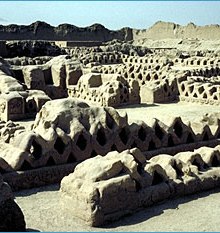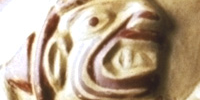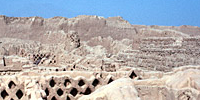explore
South America - Coastal Desert

Chan Chan was the capital city of the Chimú kingdom and the largest municipality in the ancient Americas. Rich and poor were kept separated by high adobe (mud-brick) walls.
In the western Central Andes of South America, a narrow strip of desert - one of the driest in the world - runs along the coast of Peru and is crossed by at least 50 rivers that flow down from the Andes in the east. Only some of these rivers have water all year round. The region has been subject to a devastating climatic event known as El Niño which can bring both drought and flood inducing rains. Ancient Andean peoples developed sophisticated ways of coping with the challenges of their environment and some of the most powerful Andean societies developed in these coastal areas, supported by irrigation agriculture.
The theme of this section is landscapes, which are the surroundings, both natural and built, that humans live within. Choose a link below to explore the coastal desert landscape.
Chan Chan was the capital city of the Chimú kingdom, the second largest indigenous state in South America, controlling roughly 1,000 km of Peru's Pacific coast. It was the largest municipality in South America between the 13th and 15th centuries A.D. At its peak, the Chimú kingdom encompassed two-thirds of all irrigated land within the coastal desert and ruled over two-thirds of the coastal population.
The rulers of Chan Chan challenged the ruthless expansion of the highland Inka, who had designs on the Chimú kingdom, wishing to absorb it into their rapidly expanding empire (which would become the largest indigenous state in the Americas). By the year 1470, the Chimú could hold out no longer and were defeated by the Inka forces, who proceeded to dismantle Chimú society, reorganizing it to better serve the Inka rulers in their capital, Cusco. The Spanish arrived some 65 years later to find Chan Chan partially abandoned and great swaths of the population already dying from Old World diseases. Illnesses such as small pox had spread quickly as pandemics, after early indigenous contact with Spaniards in Mexico, and preceded the arrival of Europeans in South America.

